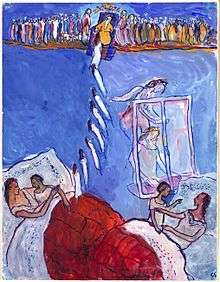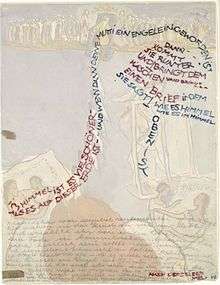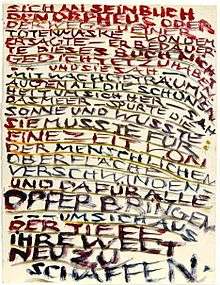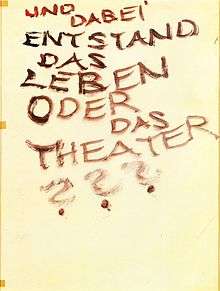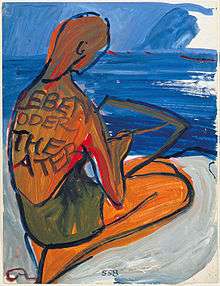Charlotte Salomon
| Charlotte Salomon | |
|---|---|
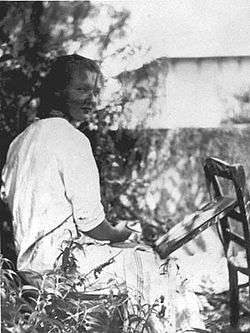 Charlotte Salomon painting in the garden of the Villa L'Ermitage, Villefranche-sur-Mer, about 1939 | |
| Born |
April 16, 1917 Berlin |
| Died |
10 October 1943 (aged 26) Auschwitz |
| Resting place | 50°02′05″N 19°10′33″E / 50.034752°N 19.175804°E |
| Nationality | German |
| Notable work | Leben? oder Theater?: Ein Singspiel |
| Movement | Expressionism |
| Spouse(s) | Alexander Nagler |
Charlotte Salomon (April 16, 1917 – October 10, 1943) was a German-Jewish artist born in Berlin. She is primarily remembered as the creator of an autobiographical series of paintings Leben? oder Theater?: Ein Singspiel (Life? or Theater?: A Song-play) consisting of 769 individual works painted between 1941 and 1943 in the south of France, while Salomon was in hiding from the Nazis. In October 1943 she was captured and deported to Auschwitz, where she and her unborn child were gassed to death by the Nazis soon after her arrival.[1][2][3] In 2015, a stunning nineteen-page confession by Salomon to the fatal poisoning of her grandfather, kept secret for decades, was released by a Parisian publisher.[4]
Biography
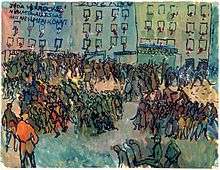

Charlotte Salomon came from a prosperous Berlin family. Her father, Albert Salomon was a surgeon;[7] her mother, sensitive and troubled, committed suicide when Charlotte was nine[8]. (This fact was concealed from her until she was twenty-two.) Charlotte was sixteen when the Nazis came to power in 1933. She simply refused to go to school, and stayed at home.
At a time when German universities were restricting their Jewish student quota to 1.5% of the student body (providing their fathers had served on the front line in the First World War), Charlotte succeeded in gaining admission to the Vereinigte Staatsschulen für freie und angewandte Kunst (United State Schools for Pure and Applied Arts) in 1936. She studied painting there for two years, but by summer 1938 the antisemitic policy of Hitler's Third Reich meant that it was too dangerous for Charlotte to continue attending the college and she did not return, despite winning a prize.[9]
Charlotte's father was briefly interned in Sachsenhausen concentration camp in November 1938, after Kristallnacht, and the Salomon family decided to leave Germany. Charlotte was sent to the South of France to live with her grandparents, already settled in Villefranche-sur-Mer near Nice. They lived in a cottage in the grounds of a luxurious villa L'Ermitage (now demolished) owned by a wealthy American, Ottilie Moore, who went on to shelter a number of Jewish children. Charlotte left L'Ermitage with her grandparents to live in an apartment in Nice, where her grandmother attempted to hang herself in the bathroom. Charlotte's grandfather then revealed the truth to Charlotte about her mother's suicide, as well as the suicides of her aunt Charlotte, her great grandmother, her great uncle, and her grandmother's nephew. Shortly after the outbreak of war in September 1939, Charlotte's grandmother succeeded in taking her own life.
Charlotte and her grandfather were interned by the French authorities in a bleak camp in the Pyrenees called Gurs. Charlotte recalls in Life? or Theater? that spending a night in a crowded train is preferable to spending one night with her grandfather: "I'd rather have ten more nights like this than a single one alone with him" .[10] His constant request to share his bed with her and her own words in a confession letter of 35 pages made public in 2015 reveal the possibility of sexual abuse.
They are released on account of her grandfather's infirmity. Her grandfather went back to Nice to live, and in Villefranche, Charlotte was facing a nervous breakdown after all the revelations, topped with the disgust for her grand-father. She writes in Life? or Theater? that it was Herr Doktor Lüdwig Grünwald, not "Herr Hitler", who "symbolized for me the people I had to resist. Dr George Morridis, the local doctor, advised her to paint.[10]
Charlotte rented a room in the pension La Belle Aurore in Saint-Jean-Cap-Ferrat and there Charlotte Salomon commenced the great work that would outlive her short life.
Charlotte Salomon began her series of 769 paintings – entitled Life? or Theater? – by stating that she was driven by "the question: whether to take her own life or undertake something wildly unusual".
In the space of two years, she painted over a thousand gouaches, working with feverish intensity. She edited the paintings, re-arranged them, and added texts, captions, and overlays. She had a habit of humming songs to herself while painting.[11] The entire work was a slightly fantastic autobiography preserving the main events of her life – her mother's death, studying art in the shadow of the Third Reich, her relationship with her grandparents – but altering the names and employing a strong element of fantasy. Charlotte also added notes about appropriate music to increase the dramatic effect, and she called Life? or Theater? a "Singespiel", [sic] or lyrical drama.
In 1942, her residence permit depending on her being her grand-father's caretaker, she joined him in Nice. She then admittedly poisoned him with a home made veronal omelette, drawing his portrait and writing a 35 pages confession letter to her former lover Alfred Wolfsohn, who never received the letter.[12][10][13] [14]
In 1943, as the Nazis intensified their search for Jews living in the South of France, she handed the work to a trusted friend with the words, "Keep this safe, it is my whole life."
By September 1943, Charlotte Salomon had married another German Jewish refugee, Alexander Nagler. The two of them were dragged from their house and transported by rail from Nice to the Nazi "processing centre" at Drancy near Paris.[15] By now, Charlotte Salomon was five months pregnant. She was transported to Auschwitz on 7 October 1943 and was probably gassed on the same day that she arrived there (October 10).[16]
Life? or Theater? (Leben? oder Theater?)
This series of gouaches is an extraordinary and unique document. In great detail it tells the story of Salomon's family and friends, her own internal life, the political background, and her obsessive love affair. Salomon had artistic training and her household was highly cultured. The way she tells her story is full of tragedy, but the telling also reveals Salomon's sly humour and wit. The series starts out with highly detailed and multi-layered images of the life and relationship between her mother and father. As the story unfolds the style gets broader and more expressionistic. The last 'chapters' are almost violent in their expression, as if Salomon is aware of her impending fate and can hardly wait to write and paint the details of her story as the Gestapo close in on her life.
A large part of Life? or Theater? is about her obsession with Amadeus Daberlohn, a voice teacher she met through her stepmother Paulinka Bimbam (Salomon gives all her characters humorous, often punning, pseudonyms). These sections are honest and compelling accounts of her passionate relationship with Alfred Wolfsohn – the one person who took her artistic work seriously. It is not possible to know if Salomon's version of her relationship with Wolfsohn corresponds with reality, but he was undoubtedly her first love.[17]
In 1943, when she was 26, Charlotte Salomon gave her collection of paintings to Dr. Moridis, a trusted friend who had treated her grandmother's depression.[18]
Life? or Theater? is intended as a Gesamtkunstwerk, a Wagnerian 'total work of art' within the tradition of the ambitious nineteenth century German idea to fuse poetry, music and the visual arts. Yet Salomon's work is a reversal of that tradition which was intended to be the ultimate manifestation of Germanic culture – instead it is a deeply moving and personal masterpiece, created by a "young woman who belonged to a supposedly alien race and who was therefore held not to even have a right to exist, let alone a place in society."[19]
Transparencies
The work includes some two hundred transparencies carrying text intended to overlay their associated gouaches. The example illustrated is typical. It is the closing gouache of Scene 1 of the Prelude and depicts the fictional Charlotte Kann (representing Salomon herself) in bed with her mother Franziska, who is telling Charlotte how wonderful it is in Heaven and how one day she (Franziska) will go there and turn into an angel and bring Charlotte a letter to lie on her windowsill describing life in Heaven.
Signature image
The "signature image" (cf. Michael Steinberg 2005, p. 1) of Life? or Theater? occurs as the final image of the concluding Epilogue section. Steinberg is reminded of Franz Kafka's short story In the Penal Colony, in which sentence of execution is inscribed on the victim's back, and describes the image as combining the innocence of the mermaid of Copenhagen with violent narrative.
Because of the nature of the work, it requires three images adequately to convey it. The image on the left is of the last page (verso) of four pages of densely packed text, carried on both sides, that conclude the epilogue. The center image is the final example of the transparent overlays that occur throughout the work, while the rightmost image is the gouache most closely associated with the work, depicting Charlotte Salomon kneeling before the sea with brush and paper in her hand and the words Life or Theater inscribed on her back.
The concluding words of the epilogue, quoting ideas of Alfred Wolfsohn,[25] are as follows:
...und sie sah – mit wachgeträumten Augen all die Schönheit um sich her – sah das Meer spürte die Sonne und wusste: sie musste für eine Zeit von der menschlichen Oberfläche verschwinden und dafür alle Opfer bringen – um sich aus der Tiefe ihre Welt neu zu schaffen
Und dabei entstand
das Leben oder das Theater???... And with dream awakened eyes she saw all the beauty around her, saw the sea, felt the sun, and knew she had to vanish for a while from the human surface and make every sacrifice in order to create her world anew out of the depths.
And from that came
Life or Theater???
Singespiel
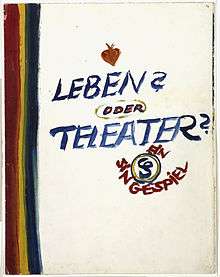
Salomon entitled her work, Leben? oder Theater?: Ein Singspiel. Singspiel is a German music form resembling "operetta" in some respects, although actors' parts are often spoken over, rather than sung with the music. Music provides the backdrop for the play-form which is most often comical in nature, tragedy being a less-frequent motif. Romantic interest nearly always plays a prominent part. Singspiel was considered less elevated than opera proper, often being written in the vernacular (German or French).[27] Note that Salomon's spelling, "Singespiel", adds an "e", but whether this was intentional or not is unclear. While celebrated composers such as Bach and Hiller are known to have worked in the form, Singspiel often introduced folksongs, marches and narrative songs into its repertoire. The plays were usually performed by traveling troupes and not necessarily by established companies within metropolitan centers. By the early twentieth century, at the time of Salomon's appropriation of the form into her work, the Singspiel had ceased to be an active category of musical performance anywhere. Thus, Life? or Theater? is not only a series of paintings. It includes a script in the form of words that are either themselves in the form of paintings, written into the paintings, or presented as overlays to the images. It also has a "soundtrack" – music chosen by Salomon that reinforces her stories. These range from Nazi marching songs to Schubert lieder and extracts from the music of Mozart and Mahler. The work is operatic in scale, highly modern in execution, unique in its form, and has an enduring power.
Reputation
In exhibitions and art history
The paintings that make up Life? or Theater? began to be exhibited in the 1960s only, the first book with 80 reproductions was published in 1963, and drew comparisons with the story of Anne Frank.[28] Marc Chagall was shown the paintings and was impressed. In 1971 the collection was placed in the care of the Joods Historisch Museum, Amsterdam. In 1981 the Museum presented 250 scenes in narrative sequence, and critics began to comment on the work.[28] An exhibition at the London Royal Academy in 1998 was an unexpected sensation, helped by the publication of a complete catalogue.[Notes 1] The work is still relatively little known, in part because Salomon's work doesn't appear on the international art market, as the whole archive belongs to the protective Charlotte Salomon Foundation based at the Joods Historisch Museum. The art historian Griselda Pollock dedicated to Charlotte Salomon a chapter in her Virtual Feminist Museum, analysing her work in terms of contemporary art, Jewish history and cultural theory.[29]

In the performing arts
There have been several other exhibitions of parts of Life? or Theater?, and a number of films and plays made about Charlotte Salomon's life, notably Company of Angels by the UK theatre company Horse and Bamboo Theatre and in 1981, Dutch director Frans Weisz released a feature film based on her life, entitled Charlotte, with the Austrian actress Birgit Doll playing the artist and Daberlohn played by Derek Jacobi. In 2011 he made a documentary revealing the contents of her last letter to Wolfsohn.
Saving Charlotte, a play by Judi Herman, was performed at the Bridewell Theatre, London, in October/November 1998.
Lotte's Journey, a play by Candida Cave, was performed at New End Theatre, Hampstead, in October/November 2007.
In remembrance of the artist, French composer Marc-André Dalbavie dedicated an opera to her: Charlotte Salomon, commissioned by the Salzburg Festival. The libretto by Barbara Honigmann is based on the gouaches Leben? oder Theater? and integrates them into the performance in form of projections. The main role of Charlotte is performed by two artists, an actress and a singer. Most of the singing is done in French while the spoken parts are in German. The world premiere took place at Salzburg's Felsenreitschule on 28 July 2014 on a panorama stage of 30 meters, conducted by the composer and directed by Luc Bondy. The two Charlotte Salomon roles were spoken by German Johanna Wokalek and sung by French Marianne Crebassa.[30] The opera and its production received rave reviews by public and press.
A novel, Charlotte, written by David Foenkinos, was published in 2014, which won the prestigious French literary prize Le prix Théophraste Renaudot, among other prizes.[31]
In February 2015, the Musiktheater im Revier (MiR) in Gelsenkirchen presented a ballet-opera by Michelle DiBucci based on life and work of the artist. Its title was Charlotte Salomon: Der Tod und die Malerin (Death and the Painter); it was choreographed and directed by Bridget Breiner. Again the autobiographical work Life? or Theater? formed the basis for the dramatization.[32] DiBucci was originally commissioned to compose an opera on the life and work of Salomon by director Marie Zimmermann for the 2010 Ruhrtriennale.[33] The work was not completed due to the death of Zimmermann in 2007. Several years later, DiBucci was approached by choreographer Bridget Breiner and asked to adapt the work into a full-length ballet. Charlotte Salomon: Der Tod und die Malerin was the winner of a 2015 Der Faust, Germany's highest honor in theatre. Bridget Breiner received the award for Best Choreography.[34]
In 2017, to coincide with the 100th anniversary of Charlotte Salomon's birth, ″CHARLOTTE: A Tri-Coloured Play with Music″ [35] was presented at the Luminato Festival in Toronto, [36] and at the World Stage Design Festival, in Taipei, Taiwan. [37] This singspiel, which "gives Salomon a wonderfully authentic and persuasive voice onstage" [38], has music by Czech composer Aleš Březina, a libretto by Canadian performer/writer Alon Nashman, and is directed and designed by UK-based Pamela Howard, author of "What is Scenography?". ″CHARLOTTE: A Tri-Coloured Play with Music″ was developed with the assistance of Canadian Stage Company, and the Isabel Bader Centre for the Performing Arts.[39] The role of Charlotte was played by Canadian soprano Adanya Dunn.
Film director Bibo Bergeron (who directed The Road to El Dorado and Shark Tale for Dreamworks) is presently making a movie about Charlotte Salomon's life and work,[31] called Charlotte, with a 10 million euro budget.
Commemoration
_Charlotte_Salomon.jpg)
Since 1992 a primary school in Berlin bears the name of the artist, in 2006 a street in Berlin-Rummelsburg was named after her. On April 21, 2012 a Stolperstein in front of her former residential house in Berlin-Charlottenburg, Wielandstraße 15, was dedicated to Charlotte Salomon. In addition a Memorial Plaque on the facade of the building commemorates the artist.[40]
Notes
- ↑ Griselda Pollock (2005 p. 34 n. 1) however criticised the 1981 catalogue as presenting a too specific framing of the work. The choice of cover art, the self-portrait uncharacteristic of her work in general with its transparent quotation of Vincent van Gogh's self portraiture and the single intimate cover title "Charlotte", establishes too early an unquestioned framing of the work as autobiographical and dramaturgy, and genders Salomon.
References
- ↑ Adam C. Stanley, "Salomon, Charlotte (1917–1943)" in Bernard A. Cook, Women and war: a historical encyclopedia from antiquity to the present, Volume 1, ABC-CLIO, 2006, p. 514.
- ↑ Gilbert, Martin (2002). The Routledge Atlas of the Holocaust. Psychology Press. p. 10. ISBN 978-0-415-28145-4.
- ↑ Pollock Conceptual Odysseys 2007, pp. 87-8.
- ↑ "The Obsessive Art and Great Confession of Charlotte Salomon". The New Yorker. Retrieved 2017-07-19.
- ↑ "Leben? oder Theater? | Joods Historisch Museum | Joods Cultureel Kwartier". Jhm.nl. Archived from the original on 2014-04-07. Retrieved 2014-08-11.
- ↑ "Leben? oder Theater? | Joods Historisch Museum | Joods Cultureel Kwartier". Jhm.nl. Archived from the original on 2014-04-07. Retrieved 2014-08-11.
- ↑ "Creativity and Its Imprint: Three Jewish Artists and Some Books About Them: Philip Guston, Charlotte Salomon, R. B. Kitaj" (PDF). Leonard Gold, Rosaline and Myer Feinstein Lecture Series. Jewishlibraries.org. 2001. Archived from the original (PDF) on 26 September 2011. Retrieved 11 July 2011.
- ↑ "Charlotte Salomon | Jewish Women's Archive". jwa.org. Retrieved 2018-02-23.
- ↑ Belinfante, pp. 17–8, 21.
- 1 2 3 Bentley, Toni (2017-07-15). "The Obsessive Art and Great Confession of Charlotte Salomon". The New Yorker. ISSN 0028-792X. Retrieved 2017-09-17.
- ↑ "Archived copy". Archived from the original on 2009-11-18. Retrieved 2010-09-05.
- ↑ "Holocaust Victim Charlotte Salomon's Intensely Personal Oeuvre Will Be Showcased for the First Time in Amsterdam". artnet News. 2017-08-23. Retrieved 2017-09-17.
- ↑ "L'art, la vie, le poison". L'Humanité (in French). 2015-10-30. Retrieved 2017-09-17.
- ↑ "The Painter Charlotte Salomon Killed Her Grandfather. Then the Nazis Killed Her". Jewniverse. 2015-12-13. Retrieved 2017-09-17.
- ↑ https://www.thejewniverse.com/2015/another-astonishingly-talented-jewish-painter-who-was-killed-by-the-third-reich/
- ↑ Biographical information from Mary Lowenthal Felstiner, To Paint Her Life: Charlotte Salomon in the Nazi Era, Harper Collins, 1994 and Adam C. Stanley, "Salomon, Charlotte (1917–1943)" in Bernard A. Cook, Women and war: a historical encyclopedia from antiquity to the present, Volume 1, ABC-CLIO, 2006, pp. 513–514.
- ↑ Charlotte Salomon: Life or Theater. The Viking Press, New York, 1981. ISBN 0-670-21283-0.
- ↑ Mary Lowenthal Felstiner, To Paint Her Life. Harper Collins 1994. ISBN 0-06-017105-7
- ↑ Norman Rosenthal p. 9, Charlotte Salomon, Life? or Theater?; Royal Academy of Arts 1998; ISBN 0-900946-66-0
- ↑ "Leben? oder Theater? Ein Singespiel | Museumstukken | Joods Historisch Museum | Joods Cultureel Kwartier". Jhm.nl. 2012-05-23. Archived from the original on 2014-04-07. Retrieved 2014-08-11.
- ↑ "Leben? oder Theater? Ein Singespiel | Museumstukken | Joods Historisch Museum | Joods Cultureel Kwartier". Jhm.nl. 2012-05-23. Archived from the original on 2014-04-07. Retrieved 2014-08-11.
- ↑ "Leben? oder Theater? | Joods Historisch Museum | Joods Cultureel Kwartier". Jhm.nl. Archived from the original on 2014-04-07. Retrieved 2014-08-11.
- ↑ "Leben oder Theater? Ein Singespiel | Museumstukken | Joods Historisch Museum | Joods Cultureel Kwartier". Jhm.nl. 2012-05-23. Archived from the original on 2014-01-02. Retrieved 2014-08-11.
- ↑ "Leben oder Theater? Ein Singespiel | Museumstukken | Joods Historisch Museum | Joods Cultureel Kwartier". Jhm.nl. 2012-05-23. Archived from the original on 2014-01-02. Retrieved 2014-08-11.
- ↑ Belinfante, p. 38.
- ↑ "Leben? oder Theater? Ein Singespiel | Museumstukken | Joods Historisch Museum | Joods Cultureel Kwartier". Jhm.nl. 2012-05-23. Archived from the original on 2014-01-02. Retrieved 2014-08-11.
- ↑ Branscombe, Peter: "Singspiel", The New Grove Dictionary of Music and Musicians, Ed. Stanley Sadie and J. Tyrrell (London: Macmillan, 2001), vol. 18, pp. 438–39.
- 1 2 Felstiner 1994.
- ↑ Griselda Pollock, Encounters in the Virtual Feminist Museum: Time, Space and the Archive. Routledge, 2007. ISBN 978-0-415-41374-9
- ↑ "Salzburger Festspiele > INSTITUTION > ARCHIV > Archivdetail".
- 1 2 Keslassy, Elsa (13 June 2016). "Bibo Bergeron Set to Direct Charlotte Salomon Animated Biopic (exclusive)".
- ↑ "Archived copy". Archived from the original on 2014-07-14. Retrieved 2016-01-07.
- ↑ "Recensie: DiBucci – Charlotte Salomon". operanederland.nl. Retrieved 2016-01-07.
- ↑ "Bridget Breiner erhält zum zweiten Mal den "Faust"". Westdeutsche Allgemeine Zeitung. Retrieved 2016-01-07.
- ↑ http://www.theaturtle.com/charlotte.html
- ↑ https://luminatofestival.com/2017/Events/Charlotte-A-Tri-Coloured-Play-with-Music
- ↑ http://www.wsd2017.com/news/detail/226
- ↑ http://www.jewishrenaissance.org.uk/blog/review-theatre-charlotte-a-tri-coloured-play-with-music/
- ↑ http://myscena.org/newswire/isabel-bader-centre-performing-arts-queens-university-presents-charlotte-tri-coloured-play-music/
- ↑ Charlotte-Salomon-Grundschule: Charlotte Salomons Leben - eine kurze Biografie
Sources
- Charlotte Salomon: Life or Theater. The Viking Press, New York, 1981. ISBN 0-670-21283-0.
- Mary Lowenthal Felstiner, To Paint Her Life. Harper Collins, 1994. ISBN 0-06-017105-7.
- Michael P. Steinberg (Editor), Monica Bohm-Duchen (Editor), Reading Charlotte Salomon, Cornell University Press, 2005. ISBN 0-8014-3971-X
- Ernst van Alphen, "Charlotte Salomon: Autobiography as a Resistance to History" in: Inside the Visible", edited by C. de Zegher, MIT Press, 1996.
- Griselda Pollock, "Theater of Memory: Trauma and Cure in Charlotte Salomon's Modernist Fairytale" in Steinberg and Bohm-Duchen (2005) ibid.
- Griselda Pollock, "Jewish space/Women's Time" in: Encounters in the Virtual Feminist Museum: Time, Space and the Archive. Routledge, 2007. ISBN 978-0-415-41374-9.
- Griselda Pollock, Life-Mapping in (ed.) Griselda Pollock, Conceptual Odysseys: Passages to Cultural Analysis, I.B. Tauris & Co Ltd, London, 2007, ISBN 978-1-84511-522-7 (pp. 63-88)
- Griselda Pollock, Charlotte Salomon and the Theatre of Memory. Yale University Press, 2018. ISBN 978-0300100723.
- Darcy C. Buerkle, Nothing Happened: Charlotte Salomon and an Archive of Suicide. University of Michigan Press, 2013.
- An eight minute film created by Studio Louter, using Salomon's original goauches, for the Jewish Historical Museum. https://jwa.org/encyclopedia/article/salomon-charlotte
- (ed.) Judith C. E. Belinfante et al, Charlotte Salomon: Life? or Theatre?. Royal Academy of Arts, London, 1998, ISBN 0-900946-66-0 (pp. 15–25)
External links
| Wikimedia Commons has media related to Charlotte Salomon. |
| Wikiquote has quotations related to: Charlotte Salomon |
- "Event – Charlotte Salomon, Life? or Theatre? and the Victory over Fear", Jewish Cultural Quarter, Amsterdam
- Vanderbilt University: The 29th Annual Holocaust Lecture Series "Against Cultural Genocide" (contains a link, by permission of the Charlotte Salomon Foundation, to a high resolution image of the gouache illustrated above depicting Charlotte Salomon working in the garden at L'Ermitage pic, archive)
- The Chronicle of Deportations (about Ottilie Moore - pdf), archive.
- Jewish Renaissance Magazine, UK
